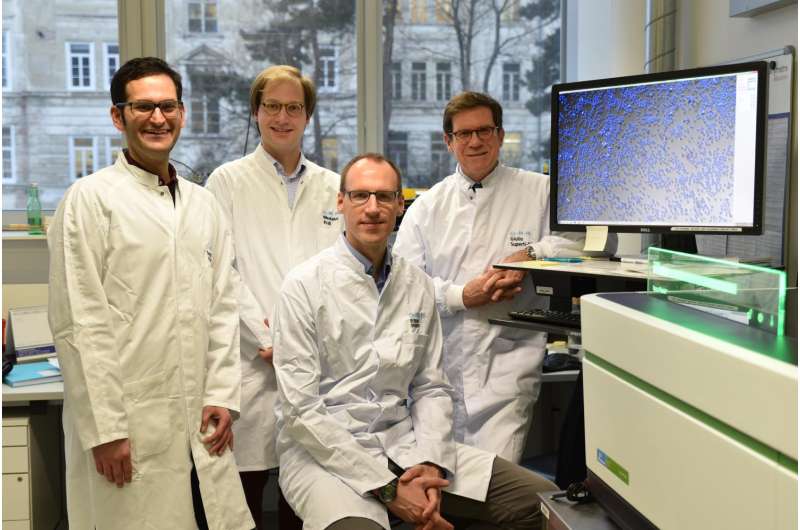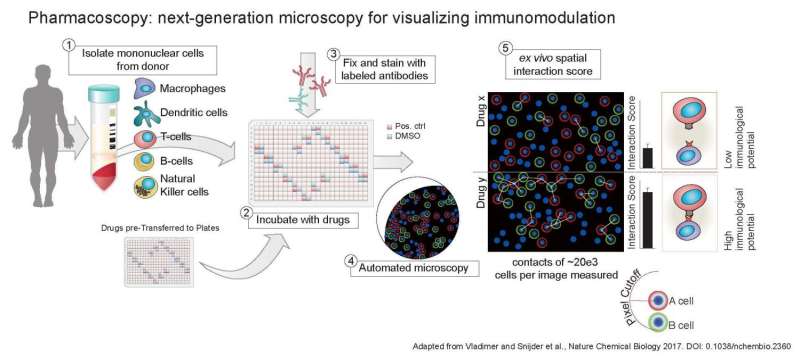'Pharmacoscopy' enables immunomodulatory drug discovery by analyzing immune cell interactions

The immune system consists of a great variety of cell types fulfilling diverse tasks in monitoring tissue homeostasis to protect against pathogens and to remove damaged cells. To ensure the smooth, controlled function of this highly complex system, immune cells use a wide range of biochemical signaling pathways activated by soluble proteins or direct cell-cell contacts. Those pathways are also targeted by modern drugs, for instance, cancer immunotherapeutic agents, that direct the immune response against specific structures or cell types.
The search for new drugs that influence the immune system in a desired manner is challenging. Immune signaling, often a combination of communication via soluble proteins and direct interaction by cell-cell contacts, is subtle and hard to track in all its nuances. So far, there has been a lack of fast and robust technology to measure the effect of a potential immunomodulatory drug in particular in a cell-cell contact dimension.
By combining state-of-the-art high-throughput fluorescent microscopy with single-cell image analysis and novel analysis algorithms, Pharmacoscopy provides a powerful solution. Developed by a group of scientists at CeMM Research Center for Molecular Medicine of the Austrian Academy of Sciences led by Director Giulio Superti-Furga and tested in collaboration with the Medical University of Vienna, Pharmacoscopy can quantify the overall spatial patterning and direct interactions of immune cells within blood with unprecedented speed and accuracy. The method was introduced in Nature Chemical Biology.

Combining single-cell resolution and fully automated platform control, Pharmacoscopy can test large drug libraries such as Stefan Kubicek's Platform Austria for Chemical Biology (PLACEBO) for compounds with immunomodulatory potential. "We found that 10 percent of all approved drugs tested influence the immune system in some way—much of which was not known," says Gregory Vladimer, one of the authors of the study.
With this method, the scientists identified Crizotinib, an FDA-approved drug for non-small cell lung cancer, to have a previously unknown immunomodulatory potential: "With Pharmacoscopy, we could track how Crizotinib enables cytotoxic T-cells to attack cancer cells," explains Berend Snijder, the other co-first author. "The compound induces the upregulation of MHC on the surface of cancer cells, a protein complex that is recognized by T-cells."
"This is the world´s first method to track the modulation of the immune system at high-resolution and high-throughput," says Giulio Superti-Furga, senior author of the study and scientific director of CeMM. "Pharmacoscopy is not only a new and powerful tool for drug discovery; it can also be implemented in basic research by visualizing the effects of signaling molecules on the immune system. In the future, Pharmacoscopy should be applied to test individual patient samples on their response to various drugs—a milestone for the development of a personalized precision medicine."
More information: Global survey of the immunomodulatory potential of common drugs, Nature Chemical Biology, nature.com/articles/doi:10.1038/nchembio.2360
Journal information: Nature Chemical Biology
Provided by CeMM Research Center for Molecular Medicine of the Austrian Academy of Sciences


















